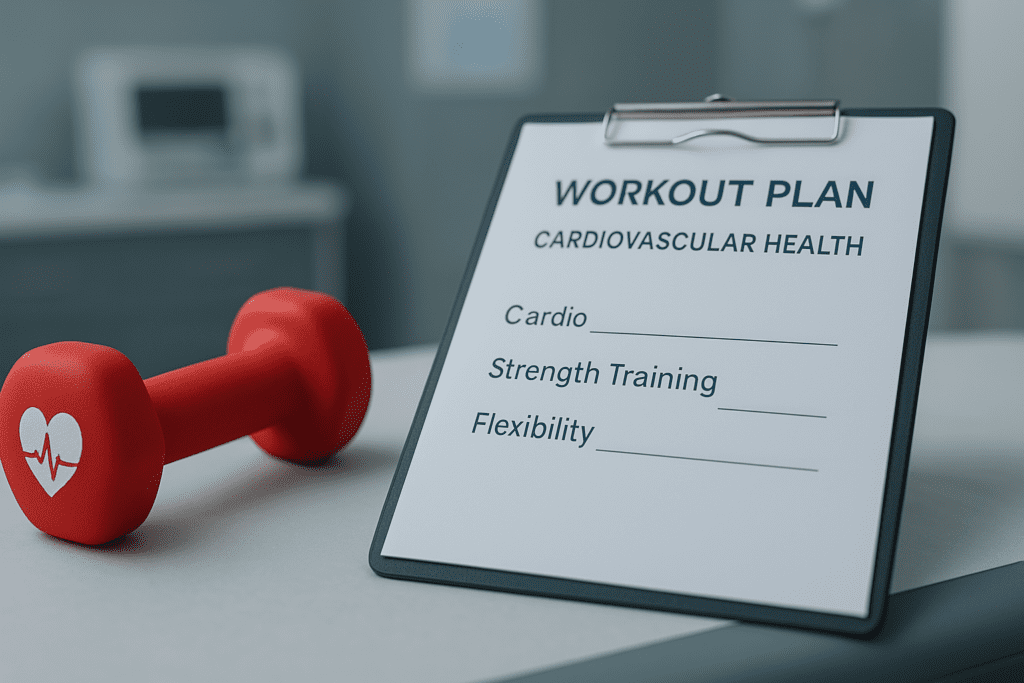In the modern health landscape, heart disease remains the leading cause of death worldwide, emphasizing the urgent need for sustainable strategies to support cardiovascular wellness. Among the most powerful and accessible tools we have is physical activity—particularly when guided by medical insight and structured through well-designed, evidence-based workout programs. Fortunately, a growing number of doctor-recommended free fitness workout plans are now widely available, offering individuals from all backgrounds an opportunity to improve heart health without the burden of cost or complexity. These plans not only enhance cardiovascular endurance but also empower users to take control of their health through strategic movement, education, and consistency.
You may also like: Top Cardiologist-Approved Cardio Workouts to Improve Cardiovascular Fitness and Heart Health Naturally
Integrating heart-smart exercise into daily life doesn’t require an expensive gym membership or complex equipment. Whether you’re starting your journey toward better heart health or refining an existing routine, there are free exercise workout plans tailored to your fitness level, preferences, and medical needs. The key lies in choosing programs that reflect sound medical advice, align with personal goals, and support long-term adherence. This article explores the science behind cardiovascular fitness, the essential components of effective routines, and how to access and implement high-quality, free workout routines with lasting impact.
The Science Behind Exercise and Cardiovascular Health
Physical activity exerts a profound influence on cardiovascular function. When you engage in aerobic or resistance-based workouts, your heart becomes stronger and more efficient at pumping blood, delivering oxygen, and regulating blood pressure. Exercise also plays a key role in modulating cholesterol levels—lowering low-density lipoprotein (LDL) while boosting high-density lipoprotein (HDL). Furthermore, consistent physical activity helps to maintain blood glucose levels, reduce inflammation, and enhance endothelial function, all of which contribute to a lower risk of atherosclerosis and coronary artery disease.
What makes this particularly compelling is the sheer accessibility of exercise as a preventive measure. Even modest changes—such as walking briskly for 30 minutes a day—can lead to significant reductions in cardiovascular risk. Research has consistently shown that regular participation in well-designed workout programs can reduce the incidence of heart attacks, strokes, and heart failure, especially when combined with healthy eating and lifestyle modifications. Free fitness workout programs that incorporate aerobic training, strength conditioning, and flexibility exercises can thus serve as foundational pillars of heart-smart living, especially for those managing conditions like hypertension, high cholesterol, or obesity.
Why Free Fitness Workout Plans Are Gaining Popularity
As healthcare costs rise and access to professional fitness guidance remains limited in many areas, the demand for free fitness plans has surged. But popularity alone doesn’t equate to quality. The best free workout routines are those that are grounded in medical science, promote safe progression, and offer clear guidance for users of varying abilities. Fortunately, several reputable sources—such as academic medical centers, public health organizations, and certified trainers—have created free gym workout plans and at-home routines that meet these criteria.
One of the key advantages of free fitness workout plans is flexibility. Users can modify intensity, duration, and format based on their physical condition, goals, or time constraints. These programs often include visual demonstrations, printable guides, and mobile apps that allow for real-time tracking and motivation. For individuals with cardiovascular disorders or those recovering from cardiac events, access to structured yet adaptable plans is especially vital. When prescribed or recommended by a physician, such programs can be integrated into cardiac rehabilitation strategies or long-term management plans to optimize heart health outcomes.
Moreover, free exercise workout plans remove many of the traditional barriers to entry, including financial cost, geographic limitations, and social anxiety. Whether you prefer working out at home, in the park, or at a local community center, these programs can be customized to fit your environment and lifestyle. As such, they represent a democratization of cardiovascular care—empowering individuals to take proactive steps toward health without needing a gym membership or expensive equipment.

Key Elements of Doctor-Recommended Cardiovascular Workout Programs
The foundation of any heart-smart fitness plan lies in the balance of aerobic exercise, strength training, and recovery. Aerobic activities—such as brisk walking, cycling, swimming, or dancing—are the cornerstone of cardiovascular health, improving circulation, oxygen uptake, and heart efficiency. Most cardiologists and exercise physiologists recommend a minimum of 150 minutes of moderate-intensity aerobic activity per week, divided into manageable sessions that suit the individual’s endurance and medical condition.
Strength training also plays a critical role in supporting cardiovascular health. While it is often associated with building muscle, resistance exercises improve insulin sensitivity, reduce visceral fat, and enhance metabolic rate—all of which reduce heart disease risk factors. Free gym workout plans often include bodyweight exercises like squats, lunges, push-ups, and core work, all of which can be modified for beginners or those with joint limitations.
Equally important is the inclusion of warm-ups, cool-downs, and flexibility work. Stretching not only helps to prevent injury but also improves circulation and musculoskeletal alignment, which can enhance exercise performance and recovery. A comprehensive free fitness workout plan should guide users through these phases with detailed instruction to ensure safety, especially for individuals with cardiovascular conditions or mobility issues. By incorporating elements of mindfulness, breathing exercises, and recovery strategies, these plans also address the often-overlooked connection between stress, mental health, and heart disease.
How to Choose the Right Free Fitness Plan for Your Heart
Choosing a workout program for cardiovascular health should begin with a self-assessment and, when possible, a consultation with a healthcare provider. Factors like age, medical history, current medications, and baseline fitness level should all influence the type and intensity of exercise. For instance, someone recovering from a mild cardiac event might benefit from low-impact aerobic sessions and gradual resistance training, whereas an individual with well-managed hypertension may be ready for interval-based workouts.
Reputable free fitness plans typically offer multiple levels of intensity and duration, allowing users to select the option that aligns with their current abilities. It’s also important to look for plans that are adaptable and progressive—meaning they provide opportunities for advancement as your strength, endurance, and confidence improve. Plans that integrate rest days and encourage cross-training can further support cardiovascular resilience while preventing overuse injuries and plateaus.
Another consideration is the format and accessibility of the program. Some free exercise workout plans are available as downloadable PDFs, while others are embedded into apps with video tutorials, progress trackers, and community features. The best workout programs offer a clear structure with actionable goals, such as completing three workouts per week, walking a set number of steps, or gradually increasing aerobic duration over time. Consistency, more than perfection, is the key to cardiovascular improvement.
Integrating Free Workout Routines Into Your Lifestyle
Embedding a fitness routine into your everyday life requires intentionality, support, and realistic expectations. Rather than viewing exercise as an isolated event, it’s more effective to treat movement as a core part of your daily rhythm. Starting the day with a 20-minute walk, taking the stairs instead of the elevator, or using household chores as opportunities for movement can create a foundation of activity that complements structured workout sessions.
Many free gym workout plans include routines that can be performed in 20 to 40 minutes, making them ideal for individuals with busy schedules. These plans can be implemented at home using bodyweight resistance or minimal equipment like resistance bands or light dumbbells. Whether it’s an interval-based cardio session or a circuit-style strength workout, these routines can be adapted to fit a lunch break, early morning routine, or evening wind-down.
To maintain motivation and track progress, consider journaling your workouts or using free apps that align with your chosen fitness plan. Setting achievable short-term goals—such as completing four workouts per week or reducing resting heart rate over three months—can create positive momentum and reinforce the connection between effort and improvement. Social support also plays a role in adherence, so whether you partner with a friend, join an online community, or share your progress with a healthcare provider, accountability can be a powerful motivator.
Special Considerations for Individuals With Cardiovascular Disorders
When designing or following a fitness routine with an existing cardiovascular condition, safety must always come first. Conditions like heart failure, atrial fibrillation, or post-myocardial infarction status may necessitate specific exercise precautions or exclusions. For example, individuals with unstable angina should avoid high-intensity interval training (HIIT) until their condition is stabilized under medical supervision. Similarly, those with implantable devices such as pacemakers may need to avoid certain upper-body movements.
Fortunately, many free fitness workout programs are designed with these considerations in mind. Reputable platforms, particularly those affiliated with hospital systems or academic institutions, often provide medically tailored options that align with current guidelines for cardiac rehabilitation. These plans emphasize gradual progression, heart rate monitoring, perceived exertion scales, and symptom tracking. They also promote awareness of red flags—such as dizziness, shortness of breath, or chest discomfort—that may require immediate medical attention.
Beyond the physical components, these programs often address emotional well-being, which is crucial for heart patients. Depression and anxiety are common in individuals with cardiovascular disease and can impact adherence to exercise. Programs that incorporate breathing techniques, mindfulness practices, or yoga-inspired movements can offer both physical and mental benefits. Free workout routines that recognize the holistic nature of cardiovascular wellness ultimately provide greater value and sustainability.
The Role of Digital Tools in Supporting Free Fitness Workout Programs
Technology has revolutionized how people access and engage with health and fitness information. With the advent of smartphones, wearable fitness trackers, and streaming platforms, high-quality workout programs are now available at the touch of a button. Many of these platforms offer free fitness workout programs curated by exercise physiologists, certified trainers, or health organizations, providing users with accurate, reliable, and diverse training options.
Wearable devices can monitor metrics such as heart rate variability, step count, oxygen saturation, and calorie expenditure—offering insight into how your body is responding to exercise. Some free gym workout plans integrate with apps that use these metrics to adjust your workout intensity in real time. This biofeedback-driven approach allows for personalized programming that meets users where they are and minimizes the risk of overexertion.
Video-based platforms like YouTube also host thousands of free workout routines, including heart-healthy walking workouts, low-impact cardio, resistance training, and chair-based exercises for those with mobility challenges. While the sheer volume of content can be overwhelming, curated lists from medical institutions or professional trainers can help narrow the field and ensure that safety and evidence-based practices are upheld.

Long-Term Benefits of Adhering to a Free Fitness Plan
The cardiovascular benefits of regular exercise extend far beyond immediate improvements in endurance or strength. Over time, consistent participation in free fitness workout plans can contribute to reduced medication dependence, fewer hospitalizations, and improved quality of life. For individuals with or at risk of cardiovascular disease, exercise can be a powerful non-pharmacologic intervention that rivals medication in its impact on longevity and vitality.
Adherence to a structured fitness routine is also associated with enhanced mental clarity, better sleep quality, improved insulin sensitivity, and a more balanced mood—all of which indirectly support cardiovascular health. Furthermore, building exercise into your lifestyle can inspire broader behavioral changes, such as smoking cessation, dietary improvements, and increased engagement with preventive healthcare.
What’s particularly encouraging is that many users who begin with free workout routines eventually develop a deep appreciation for movement that transcends the initial motivation. They begin to see exercise not as a task but as a form of self-care, stress relief, and empowerment. By reinforcing the mind-body-heart connection, these routines foster resilience, motivation, and long-term adherence.
Frequently Asked Questions: Heart-Smart Living and Free Fitness Workout Plans
1. How can I tell if a free fitness workout plan is safe for someone with a heart condition?
The safety of any fitness plan, especially for individuals with cardiovascular concerns, hinges on how well it aligns with medical guidelines and individual health status. A high-quality free fitness workout plan should begin with low-impact movements, offer progressions in intensity, and include clear modifications for joint or cardiac limitations. Look for programs that recommend warm-ups, cool-downs, and built-in rest days, as these indicate thoughtful design. Free workout routines that include target heart rate ranges, perceived exertion scales, and guidance on when to pause activity are particularly beneficial. If a plan integrates these elements and has been developed or reviewed by certified professionals, it’s more likely to support heart health without unnecessary risk.
2. Are there free exercise workout plans that incorporate mindfulness or stress management for heart health?
Yes, and this intersection is gaining popularity in cardiac wellness. Several free exercise workout plans now include breathing techniques, yoga-inspired flows, or brief meditative segments to reduce stress—a known contributor to cardiovascular strain. These hybrid routines not only strengthen the body but also regulate the nervous system and improve heart rate variability. Integrating mindfulness into free fitness workout programs can be especially helpful for those recovering from heart-related events, as it reinforces the mind-heart connection. Over time, combining physical movement with mental relaxation can enhance compliance and yield more sustainable improvements in overall heart function.
3. Can free gym workout plans really be effective without equipment or a personal trainer?
Effectiveness doesn’t always require expense or personal instruction. Many free gym workout plans rely on bodyweight exercises, resistance bands, or household items to create challenging, dynamic routines. What matters most is proper form, consistency, and progressive overload—principles that are embedded into well-structured workout programs. When following a free fitness plan, users should pay attention to pacing, rest intervals, and alignment cues often provided in video demonstrations. While personal trainers offer valuable feedback, high-quality digital programs now simulate much of that guidance through expert narration and strategic programming, making it easier than ever to see results from free fitness workout programs.
4. How do I stay motivated to follow free workout routines long-term?
Maintaining motivation involves more than just discipline—it requires emotional investment, achievable goals, and social reinforcement. Many people benefit from selecting free workout routines that align with personal interests, such as dance, martial arts, or low-impact cardio. Using a journal to track progress, setting calendar reminders, and rewarding milestones (like consistency streaks) can help maintain momentum. Some free fitness workout programs include interactive communities, live classes, or progress challenges that enhance accountability and enjoyment. Ultimately, motivation thrives when workouts feel rewarding, empowering, and seamlessly integrated into daily life—not like a burdensome obligation.
5. What’s the difference between general workout programs and those designed specifically for cardiovascular health?
General workout programs may prioritize aesthetics, strength gains, or athletic performance, whereas those designed for cardiovascular health focus on endurance, circulation, and heart function. A heart-healthy free fitness workout plan will prioritize aerobic activities such as walking, cycling, and circuit training while moderating intensity to avoid overstressing the heart. These programs often include recovery metrics, heart rate tracking, and balanced progressions to support vascular integrity. In contrast, traditional gym routines might emphasize muscle hypertrophy or weight loss without considering cardiac output or systemic inflammation. Choosing workout programs built around cardiovascular metrics ensures that heart health remains the primary focus rather than a secondary benefit.
6. How can I adapt free fitness workout plans if I have limited mobility or joint pain?
Adaptability is one of the greatest strengths of well-designed free fitness workout plans. For individuals with joint pain or mobility challenges, seated routines, aquatic workouts, and isometric holds offer low-impact yet effective cardiovascular benefits. Many free exercise workout plans provide chair-based or gentle movement alternatives that reduce strain while still elevating heart rate. The key is to prioritize functional movement patterns and avoid high-impact jumps or abrupt directional changes. Over time, these tailored modifications allow individuals to build strength, increase flexibility, and improve circulation without exacerbating underlying issues, making movement more accessible for diverse populations.
7. Are there differences between men’s and women’s free workout routines for cardiovascular health?
While cardiovascular principles are generally universal, free workout routines can differ based on the unique physiological responses, hormone profiles, and health concerns of men and women. For example, women may benefit from workout programs that emphasize bone density and pelvic stability, particularly around perimenopause, while men may focus more on blood pressure control and abdominal fat reduction. Some free fitness workout programs address these nuances with gender-tailored sessions, offering alternative progressions, hormonal balance considerations, or targeted recovery strategies. However, most well-rounded free gym workout plans are suitable for both sexes with only minor adjustments based on individual needs.
8. How can free fitness plans support long-term heart disease prevention?
Preventing heart disease involves consistent lifestyle intervention, and structured free fitness plans provide the framework for lasting behavioral change. Over months or years, individuals who adhere to free fitness workout programs often experience reduced blood pressure, improved lipid profiles, and enhanced glucose regulation—all critical factors in heart disease prevention. These programs encourage the development of healthy habits such as daily movement, conscious breathing, and improved sleep hygiene. When combined with dietary improvements and regular medical checkups, a free fitness workout plan becomes a foundational component in the broader strategy for long-term cardiovascular resilience. The cumulative effect of small daily choices, guided by these plans, is profound.
9. What technological tools can enhance my experience with free fitness workout programs?
Technology plays a transformative role in elevating engagement and outcomes with free fitness workout programs. Wearables like smartwatches and heart rate monitors offer real-time feedback, allowing users to stay within safe exertion zones or track aerobic improvements. Fitness apps often integrate free workout routines and sync with digital calendars to promote consistency. Many platforms also use AI or machine learning to personalize workout programs based on user input, making them more responsive to individual performance and recovery needs. Virtual reality (VR) workouts and gamified apps are also emerging as engaging tools that provide immersive fitness experiences while still supporting heart health goals.
10. What are the long-term psychological benefits of following a free exercise workout plan?
Beyond physical advantages, the psychological effects of a consistent free exercise workout plan are both profound and measurable. Regular physical activity is known to reduce symptoms of anxiety and depression by modulating neurotransmitters such as serotonin and dopamine. When individuals follow structured free workout routines, they often report improved self-esteem, greater stress tolerance, and increased emotional resilience. The routine itself provides structure, a sense of control, and goal-setting opportunities—all of which contribute to psychological well-being. Furthermore, the accessibility of free gym workout plans removes financial stressors, allowing individuals to focus purely on health without the burden of cost-related barriers.

Conclusion: Embracing Free Fitness Plans as a Lifelong Cardiovascular Strategy
As the global burden of cardiovascular disease continues to grow, embracing preventive strategies has never been more essential. Among the most effective and empowering of these is regular physical activity—especially when it’s accessible, adaptable, and aligned with medical guidance. Doctor-recommended free fitness workout plans offer a compelling solution by combining evidence-based practices with real-world flexibility and cost-free accessibility.
Whether you’re recovering from a heart condition, managing risk factors, or simply seeking to protect your long-term health, there are free gym workout plans and free exercise workout plans tailored to your needs. By integrating these programs into your routine and aligning them with expert recommendations, you can build a sustainable foundation for heart-smart living that transcends trends and economic barriers.
These workout programs aren’t just about burning calories—they’re about strengthening the most vital organ in your body, cultivating resilience, and fostering a proactive relationship with health. In a world where so many aspects of wellness can feel out of reach, the availability of free workout routines brings powerful cardiovascular care into the hands of everyday people. When approached with consistency, mindfulness, and the support of medical insight, these programs become more than routines—they become lifelines to a longer, stronger, and more vibrant future.
cardiovascular exercise benefits, heart health workouts, beginner fitness for heart patients, low impact cardio, at-home fitness routines, exercise for hypertension, heart-healthy lifestyle tips, doctor-approved fitness plans, cardiac rehabilitation exercises, improving heart endurance, safe exercise for seniors, home workouts for heart disease, fitness and blood pressure control, aerobic activity for adults, building cardiovascular strength, exercise and heart disease prevention, healthy heart habits, medical fitness guidance, fitness routines for chronic conditions, long-term exercise adherence
Further Reading:
The ‘best’ cardio workout for a healthy heart
Cardio Workouts to Boost Heart Health
30 ways to Improve Your Heart Health Naturally
Disclaimer
The information contained in this article is provided for general informational purposes only and is not intended to serve as medical, legal, or professional advice. While MedNewsPedia strives to present accurate, up-to-date, and reliable content, no warranty or guarantee, expressed or implied, is made regarding the completeness, accuracy, or adequacy of the information provided. Readers are strongly advised to seek the guidance of a qualified healthcare provider or other relevant professionals before acting on any information contained in this article. MedNewsPedia, its authors, editors, and contributors expressly disclaim any liability for any damages, losses, or consequences arising directly or indirectly from the use, interpretation, or reliance on any information presented herein. The views and opinions expressed in this article are those of the author(s) and do not necessarily reflect the official policies or positions of MedNewsPedia.


